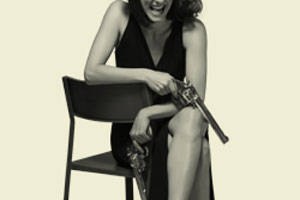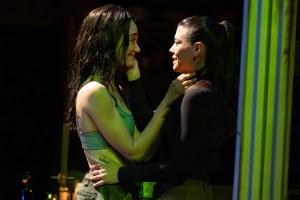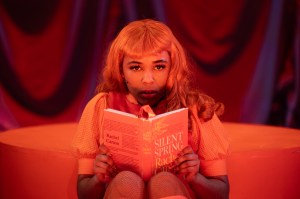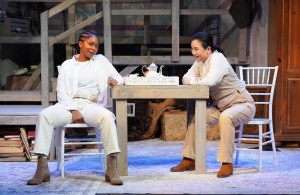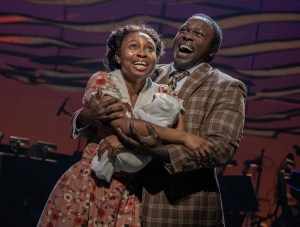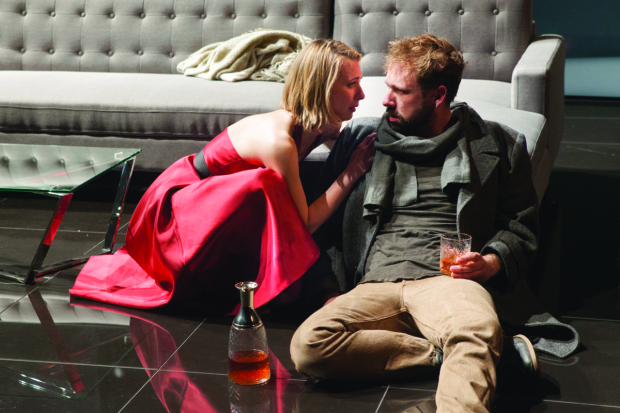
(© Allie Dearie)
Henrik Ibsen's Hedda Gabler examines love, control, sex, power, and self-delusion, but what made it scandalous in 1890 when Ibsen wrote it, is that those issues were considered from a woman's point of view. Studio Theatre's Hedda Gabler is the American premiere of Mark O'Rowe's new adaptation. It jettisons the usual 19th-century clothes and furniture and quickly gets to the meat of Ibsen's play: the story of a young woman who feels manipulated by the conditions of her life and who simultaneously fears and loathes the society around her. She yearns to break away from the constraints that bind her, yet she is afraid of what will be thought of her if she manages to do so.
The play begins with the return of Hedda and her husband, Jorge Tesman, to their new home. They have been away on a long honeymoon and get home to find her husband's aunt, Julie Tesman, waiting to see her favorite nephew. Soon another helpless woman comes calling. Thea Elvsted was at school with Hedda long ago and admits that Hedda frightened her even then, with good reason. Hedda apparently threatened to set Thea's hair on fire, and Thea has had a healthy fear of Hedda ever since. But she comes to her now because she doesn't know where else to turn. Their mutual acquaintance, Ejlert Lovborg, a former alcoholic and womanizer, is in town. For years, Ejlert has been living in the north, tutoring Thea's children and getting clean and sober. He has written a book that has just been published to great acclaim, and Thea has been helping him write his next book, which is in draft form. Now, Thea fears, Ejlert may fall back into his old, self-destructive patterns: drinking too much and visiting houses of prostitution.
Ibsen rounds out his group of characters by introducing two more men: Judge Brack, an unctuous manipulator who loves to flirt with women and has already exerted some control over Hedda by making it possible for Jorge to buy her new house; and Lovborg, who had more than just an innocent relationship with Hedda before she was married. When all these characters are assembled together, and Hedda realizes that mousy little Thea and Ejlert have more than a professional relationship, it drives her mad. She can't stand the fact that someone else should have Ejlert's love when she always thought she should have it. When Hedda realizes she has nothing to live for, she explodes, destroying Ejlert, his new book, her marriage, and herself.
Julia Coffey is stunning as Hedda, demonstrating the many different sides of Hedda's personality. Coffey's Hedda is sweet, cunning, shrewish, gentle, and selfish, and she makes it clear why some men are attracted to her. Avery Clark is appropriately nerdy as the pedantic Jorge, who would drive any wife to distraction. Shane Kenyon is excellent as Ejlert; Kenyon captures both Lovborg's sophistication and his lack of self-control. Michael Early creates a thoroughly horrid Brack, interested only in his own power over others. Thea is portrayed, by Kimiye Corwin, as a timid bird. Kimberly Schraf plays Aunt Julia as a nervous, ultra-conventional relative.
Director Matt Torney keeps the action moving swiftly, at times taking the pace up a bit, especially during the tense moments, like when Hedda grabs Thea's hair and wrestles her to the floor. When Brack threatens to control Hedda sexually, however, Torney slows the pace to a near standstill. Set designer Luciana Stecconi has given Hedda a thoroughly modern home. French doors stretch from floor to ceiling behind gray, upholstered sofas and glass and stainless-steel tables. Costume designer Murell Horton gives Hedda three stunning outfits, including one for a funeral: a revealing black lace, form-fitting dress worn over a pink slip.
This Hedda Gabler is a total resurfacing of the text, done deliberately to allow the viewer to better see all the kinks, quirks, and malformations in Hedda's mind. And, as there is always something that neither psychology nor sociology can explain about Hedda, that is a good thing. The combination of O'Rowe's adaptation and Torney's direction allow the 21st century to better understand the complex, nuanced character of Hedda Gabler that Ibsen intended.




